- News
- City News
- delhi News
- Between Rithala and Narela, DMRC to run Metrolite trains alongside vehicles
Trending
This story is from October 19, 2019
Between Rithala and Narela, DMRC to run Metrolite trains alongside vehicles
The capital’s first Metrolite corridor will come up between Rithala and Narela as part of Delhi Metro’s Phase IV project. Trains on this 22-km stretch will run on a rail corridor fenced on both sides.

Representative image
NEW DELHI: The capital’s first Metrolite corridor will come up between Rithala and Narela as part of Delhi Metro’s Phase IV project. Trains on this 22-km stretch will run on a rail corridor fenced on both sides. Though the Lajpat Nagar-Saket G Block (7.9 km) and Inderlok-Indraprastha (12.5 km) corridors of Phase IV were also considered for the surface-level Metrolite service, Mangu Singh, managing director, Delhi Metro Rail Corporation, said these sections would get the regular metro corridors.

While similar light rail projects in other cities around the world share road space with other modes of transport, Singh said the Rithala-Narela corridor and the Kirti Nagar-Dwarka ECC corridor, which will come up later, will have dedicated fenced corridors.
"We decided that Metrolite would have 100% right of way and run at the same average speed as the metro," Singh told TOI. Wherever it is not possible to lay a dedicated corridor, such as at road intersections, Metrolite will run on elevated sections or underpasses.
Singh also said that the corridor and the stations would be located in the middle of the road. However, to approach the platform, passengers would not have to cross the road because there would be end-to-end subways from the footpaths to the station.
The Rithala-Narela, Lajpat Nagar-Saket G Block and Inderlok-Indraprastha corridors of Phase IV are yet to be approved by the central government and may be considered for Metrolite services. Singh, however, noted this wouldn’t be possible. "On both the Lajpat Nagar-Saket G Block and Inderlok-Indraprastha corridors, Metrolite would not be able to handle the capacity demand," he pointed out. "Also, there isn’t enough space on the roads at many of these places for Metrolite corridors."
The Rithala-Narela corridor will provide much-needed connectivity to Delhi Development Authority’s Narela sub-city and so the land-owing agency will partially fund the project, Singh disclosed. He said that unlike metro systems, Metrolite has simpler infrastructure because of reduced requirements, and consequently is less costly. "Going elevated or underground constitutes a major portion of project cost, but we can avoid this when running at surface," he said.
While the Metrolite has many similarities with the BRT system, Singh said the latter wasn’t successful in Delhi due to the large number of intersections. "Right of way wasn’t a factor. Had they taken care of the numerous traffic signals, the corridor wouldn’t have faced problems," he opined.

While similar light rail projects in other cities around the world share road space with other modes of transport, Singh said the Rithala-Narela corridor and the Kirti Nagar-Dwarka ECC corridor, which will come up later, will have dedicated fenced corridors.
"We decided that Metrolite would have 100% right of way and run at the same average speed as the metro," Singh told TOI. Wherever it is not possible to lay a dedicated corridor, such as at road intersections, Metrolite will run on elevated sections or underpasses.
"We realise that in Delhi it will not be possible to share the road space with other vehicles because this will considerably reduce the average speed of the train — and the average speed matters when it comes to long corridors," Singh explained. "If the average speed is 20 kmph, it will take the train an hour and a half to complete a journey and nobody will be willing to use it."
Singh also said that the corridor and the stations would be located in the middle of the road. However, to approach the platform, passengers would not have to cross the road because there would be end-to-end subways from the footpaths to the station.
The Rithala-Narela, Lajpat Nagar-Saket G Block and Inderlok-Indraprastha corridors of Phase IV are yet to be approved by the central government and may be considered for Metrolite services. Singh, however, noted this wouldn’t be possible. "On both the Lajpat Nagar-Saket G Block and Inderlok-Indraprastha corridors, Metrolite would not be able to handle the capacity demand," he pointed out. "Also, there isn’t enough space on the roads at many of these places for Metrolite corridors."
The Rithala-Narela corridor will provide much-needed connectivity to Delhi Development Authority’s Narela sub-city and so the land-owing agency will partially fund the project, Singh disclosed. He said that unlike metro systems, Metrolite has simpler infrastructure because of reduced requirements, and consequently is less costly. "Going elevated or underground constitutes a major portion of project cost, but we can avoid this when running at surface," he said.
While the Metrolite has many similarities with the BRT system, Singh said the latter wasn’t successful in Delhi due to the large number of intersections. "Right of way wasn’t a factor. Had they taken care of the numerous traffic signals, the corridor wouldn’t have faced problems," he opined.
End of Article
FOLLOW US ON SOCIAL MEDIA










